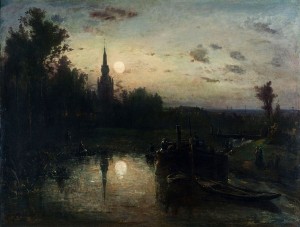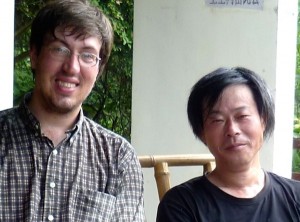Clair de Lune | Lauren Acampora
 These vibrant May mornings, the half-moon lingers low in the sky as if the night has forgotten to take it away. It’s pale and gentle behind a watery scrim, a sleek creature arching from the sea.
These vibrant May mornings, the half-moon lingers low in the sky as if the night has forgotten to take it away. It’s pale and gentle behind a watery scrim, a sleek creature arching from the sea.
The moon, my father’s pale blue eyes during his last days. The lids wavered as he drifted in and out of morphine dreams, in and out of the wood-paneled room where we’d put the hospital bed, the dark paintings on the walls, the glow of the computer screen like something from another planet.
Through that computer, I played music for him. I believed that it could reach him whether he slept or woke—that it could occupy and calm him, wend through his consciousness with pattern and purpose, the things about life I felt unable to articulate myself. He would sleep, and I would sit with him, watching the drooping eyelids, the half-moons of blue drifting below.
He loved Chopin, but Debussy’s Clair De Lune was his favorite piece.
The third movement of Suite Bergamasque is arguably the most recognizable of Debussy’s work. It was inspired by Paul Verlaine’s poem of the same name, with lines such as:
Au calme clair de lune triste et beau,
Qui fait rêver les oiseaux dans les arbres
With the still moonlight, sad and beautiful,
that sets the birds dreaming in the trees
Debussy’s musical rendering has a wandering, reluctant cadence that demands stillness, patience. The pause between notes is held just longer than expected, that additional moment containing a truth, an almost unbearable beauty that speaks of holding closely and letting go.
It’s as if the music is the moonlight—the sonic equivalent of that calm, wondering quiet.
It’s the moonlight on the streets of Venice in winter. My father, nineteen years old, AWOL from his post in Trieste in 1946, seeing the city for the first time. Walking the nearly deserted alleys in these days after the war, hearing only his own boot steps on the pavement.
It’s the peace of painting with my father in the basement, two bare light bulbs hanging over our heads. Breathing in the sweet, citrus smell of turpentine. Chiaro e scuro, he tells me. Make your darks dark and your lights light.
It’s the serenity amid the chaos in the lobby of the cancer hospital. A young man at a grand piano playing Clair de Lune beside a waterfall—a floor-to-ceiling slab of black granite with water rippling down its length, sheer and supple over the hard fact of mortality.
There is a flourish at one point in the piece, an ascension of notes like birds suddenly inspired toward flight, one after the other. Then, it’s back to the give-and-take of longing and resignation. Acceptance, and, finally, reverence.
After listening to Clair de Lune in that wood-paneled room, it has become an unending loop in my mind. But thinking of it now, I find that can’t remember the way it ends. The last notes escape me.
♦♦♦
Lauren Acampora is the author of The Wonder Garden, a collection of linked stories (Grove Atlantic, 2015). Her short fiction has appeared in New England Review, as well as Paris Review, Missouri Review, Prairie Schooner, Antioch Review, and elsewhere.
Translation from the French courtesy of Chris Routledge.
NER Digital is New England Review’s online project dedicated to original creative writing for the web. “Confluences” presents writers’ encounters with works of art such as books, plays, poems, films, paintings, sculptures, or buildings. To submit an essay to our series, please read our guidelines.

